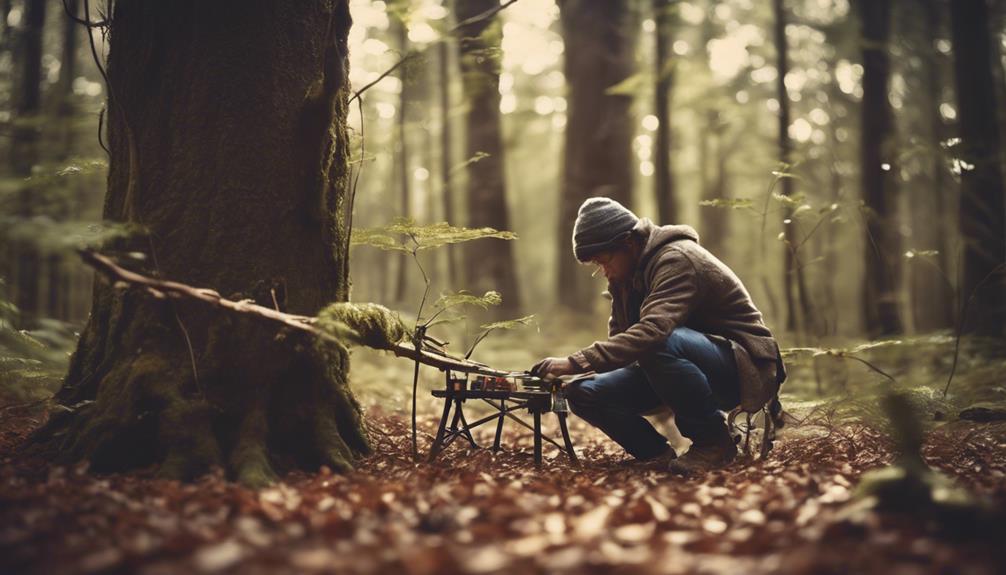A climbing tree stand elevates your hunting experience by giving you a secure platform for enhanced visibility and effective shot placement. It consists of key components like a durable platform, comfortable seat, and a climbing mechanism using straps or cables for safe ascent. Selecting the right tree is essential—choose one that’s sturdy and smooth-barked for easy climbing. Always attach your safety harness properly to prevent falls. Maintaining three points of contact during your climb is critical for stability. Prioritize safety features to enhance your overall experience, and there’s much more to explore about using these stands effectively.
Overview of Climbing Tree Stands

Climbing tree stands are vital tools for hunters, designed to elevate you above the ground for better visibility and safety while allowing you to blend into your surroundings. One of the noteworthy climbing benefits is the improved vantage point you gain, which enhances your ability to spot wildlife without being detected. When selecting the right tree for your stand, it’s essential to take into account factors like height, trunk diameter, and bark texture. Ideally, you want a tree that’s sturdy enough to support your weight and has a smooth bark for easier climbing.
Before you head out, verify you’ve practiced your setup and takedown techniques. Familiarity with your equipment can prevent accidents in the field. Always prioritize safety by using a full-body harness and safety ropes to secure yourself while climbing. Selecting a tree that’s at least 12-20 feet off the ground can help minimize your scent and noise, increasing your chances of a successful hunt. Remember, the right tree selection and proper climbing techniques not only enhance your hunting experience but also greatly reduce the risk of falls and injuries.
Key Components Explained
Understanding the key components of a climbing tree stand is vital for guaranteeing safety and maximizing performance during your hunting experience. First, let’s look at the platform. This is your main area for standing, and it should be made from durable stand materials that can support your weight while providing stability.
Next, you’ll encounter the seat. A comfortable seat is essential for long hours in the stand, and it should also be made from weather-resistant materials to withstand the elements.
The climbing mechanism is another significant component, typically comprised of a series of straps or cables that allow you to ascend and descend safely. Confirm these materials are strong and in good condition to avoid any accidents.
Lastly, don’t overlook the safety harness. This is your lifeline when you’re in a climbing tree stand, and it must fit properly and be made from high-quality materials to prevent falls. By understanding these key components, you can make informed decisions that enhance both your safety and effectiveness while hunting from an elevated position. Always prioritize quality and reliability in your climbing tree stand setup.
How to Set Up

Before you start setting up your climbing tree stand, it is crucial to select a suitable tree that offers both stability and cover for your hunting needs. Look for a straight tree with a diameter of at least 8 inches, free of dead branches or other hazards.
Once you’ve chosen your tree, consult your setup checklist to guarantee you’ve got all necessary climbing gear. This includes your harness, safety line, and any additional straps or ropes. Verify all your equipment is in good condition, as worn or damaged gear can compromise your safety.
Begin your setup by attaching your safety line to the tree at about head height. This will give you a secure point to tether yourself as you ascend. Next, position your climbing stand against the tree, making sure the platform is level and stable.
As you climb, maintain three points of contact with the tree at all times—two hands and one foot or two feet and one hand. This practice will enhance your balance and safety during the ascent. Once you’re at your desired height, secure your stand, and check that it’s stable before settling in for your hunt.
Safety Features to Consider
Safety should always be your top priority when selecting a climbing tree stand, so it’s essential to evaluate its features meticulously. Understanding the safety features can make a significant difference in your climbing experience. Here are three key elements to take into account:
- Harness Safety: Confirm the stand comes with a reliable safety harness. A full-body harness is ideal, as it distributes weight evenly and minimizes the risk of falls. Always verify that the harness meets industry safety standards.
- Stability Features: Look for stands designed with wide platforms and sturdy construction. Stability features, such as adjustable footrests and anti-slip surfaces, can enhance your security while maneuvering in the tree. This design helps prevent accidents caused by instability.
- Safety Strap Systems: Many climbing tree stands include safety strap systems that secure the stand to the tree. This feature helps prevent the stand from shifting or falling, providing an added layer of protection as you climb.
Techniques for Effective Use

Mastering effective techniques for using a climbing tree stand can greatly enhance both your safety and hunting success in the field. First, familiarize yourself with proper climbing techniques. Always verify your harness is securely fastened before ascending. Use a three-point contact method—two hands and one foot or two feet and one hand—to maintain stability while climbing.
Next, focus on positioning strategies. Scout your area beforehand to identify ideal trees that offer cover and visibility. Position your stand about 20-30 feet off the ground; this height can help you stay out of sight while still allowing for a clear shot. When setting up, consider wind direction to minimize your scent’s dispersion, and always approach your stand quietly to avoid spooking game.
Once you’re in the stand, stay alert and remain still. Minimize movement and noise, as these can easily alert wildlife. Regularly practice using your climbing tree stand to build confidence and refine your techniques. Remember, safety is paramount; verify your gear is in working order and always follow safety guidelines for a successful and secure hunting experience.
Maintenance and Care Tips
Regular maintenance of your climbing tree stand is vital to confirm peak performance and longevity, so you should inspect all components for wear and tear before each hunting season. An effective inspection checklist is fundamental for securing your safety and the stand’s reliability. Here are three key areas to focus on:
- Structural Integrity: Check for any cracks, bends, or corrosion in the frame. Pay close attention to the welds and joints, as these are critical stress points.
- Straps and Harnesses: Inspect all straps for fraying or damage. Verify that buckles function properly and replace any worn-out components immediately.
- Cleaning Procedures: Regularly clean your stand to prevent rust and deterioration. Use a mild detergent and water to remove dirt and debris, followed by a thorough drying. Consider applying a protective spray to enhance longevity.
Conclusion
To summarize, understanding how a climbing tree stand works is essential for safe and effective use. By familiarizing yourself with its key components and proper setup, you can enhance your hunting experience while prioritizing safety. Remember, maintenance is key to longevity, and employing effective climbing techniques will boost your confidence in the field. So gear up, stay cautious, and enjoy the thrill of your next ascent—after all, a well-prepared hunter is a successful one.

